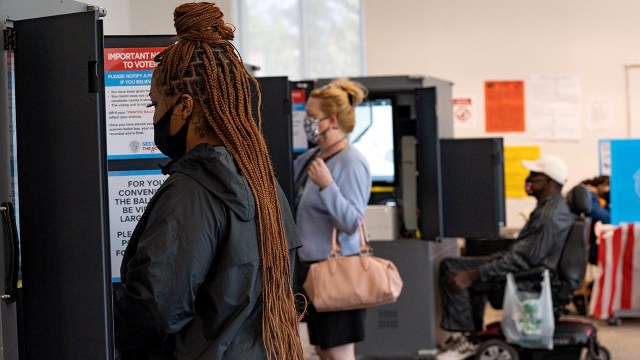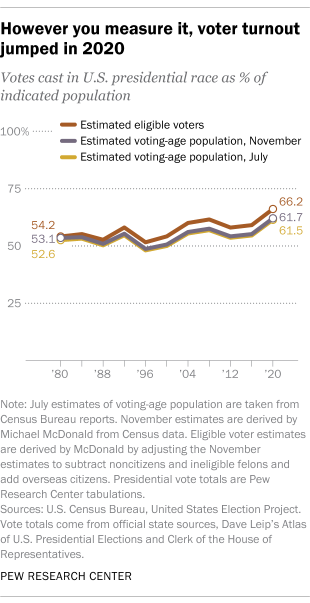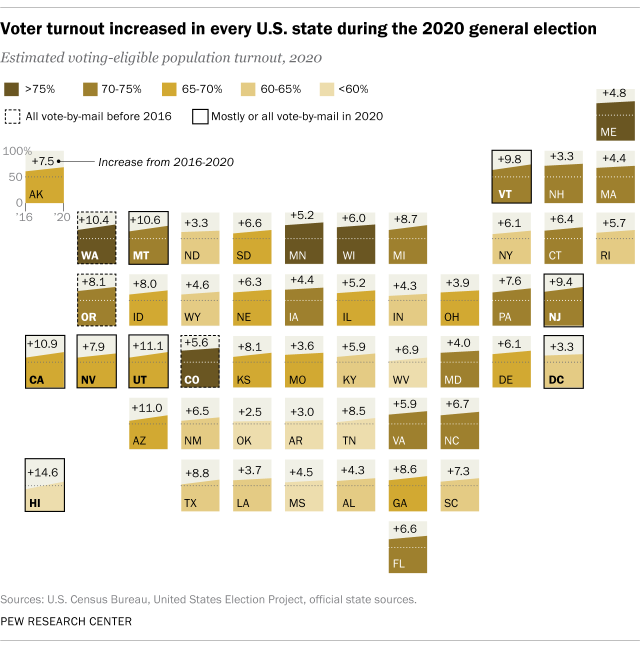
Americans voted in record numbers in last year’s presidential election, casting nearly 158.4 million ballots. That works out to more than six-in-ten people of voting age and nearly two-thirds of estimated eligible voters, according to a preliminary Pew Research Center analysis.
Nationwide, presidential election turnout was about 7 percentage points higher than in 2016, regardless of which of three different turnout metrics we looked at: the estimated voting-age population as of July 1, that estimate adjusted to Nov. 1, and the estimated voting-eligible population, which subtracts noncitizens and ineligible felons and adds overseas eligible citizens. Based on these measures, turnout was the highest since at least 1980, the earliest year in our analysis, and possibly much longer.
The rise in turnout was fueled in part by the bitter fight between incumbent President Donald Trump and challenger Joe Biden: A preelection survey found a record share of registered voters (83%) saying it “really matter[ed]” who won. But another big factor was the dramatic steps many states took to expand mail balloting and early voting because of the COVID-19 pandemic.
Turnout rates increased in every state compared with 2016, but of the 10 states where it rose the most, seven conducted November’s vote entirely or mostly by mail, our analysis shows. Six of those states had recently adopted all-mail voting, either permanently (Utah and Hawaii) or for the 2020 elections only (California, New Jersey, Vermont and most of Montana).
The past two months have been among the most turbulent post-election periods in American history, with unfounded but constantly repeated claims of voting fraud culminating in the Jan. 6 attack on the U.S. Capitol by a mob of Trump supporters. Given the continuing divides over the 2020 presidential election, we wanted to put the actual, verified turnout into some broader context. (The Census Bureau typically releases a detailed report on registration and voting after every national election, but that’s not likely to come out for several months yet.)
Measuring U.S. voter turnout is one of those things that seems intuitively straightforward but in practice is anything but. U.S. elections are run not by a single national agency, as in many other advanced democracies, but by individual states and counties within states. There is no central registry of eligible voters, no uniform rules for keeping registrations current, and no requirement to report vote totals in a consistent way.
All of which means that calculating turnout rates inevitably involves judgment calls – both in choosing which votes to include (the numerator) and the population against which to compare them (the denominator).
For this post, we originally wanted to base our analysis on total ballots counted, a metric that includes all ballots regardless of offices voted for. (It’s typically slightly higher than the presidential vote, since there are always some voters who skip that contest but vote in down-ballot races.) But not all states have reported total-ballots data, so we turned our attention to the presidential race, which nearly always is the one that attracts the most votes.
We compiled the official votes cast and counted for all presidential candidates (including write-in votes, when available) in 2016 and 2020, as certified and reported by each state’s chief election office. For the 2000, 2004, 2008 and 2012 elections, for which we only needed aggregate nationwide vote totals, we relied on Dave Leip’s Atlas of U.S. Presidential Elections, supplemented when necessary by data from the Clerk of the U.S. House of Representatives.
For comparative purposes, we calculated the presidential-vote totals as percentages of three separate measures of the potential voter pool: the 18-and-over population as of July 1, as estimated by the Census Bureau; those numbers interpolated to Nov. 1 by Michael McDonald, a political scientist and turnout expert at the University of Florida; and McDonald’s estimate of the voting-eligible population, which subtracts noncitizens and ineligible felons and adds overseas eligible citizens.
Estimated turnout rates for other countries, which we’ve previously written about, were obtained from the International Institute for Democracy and Electoral Assistance, which works to promote and support democracy around the world.
In Hawaii, turnout rose from 42.3% of the estimated voting-eligible population in 2016 to 57% last year, the biggest turnout increase in the country by this measurement. In Utah, turnout increased by about 11 percentage points, from 56.8% of estimated eligible voters in 2016 to nearly 68% in 2020.
The smallest turnout increases, as shares of estimated eligible voters, were in North Dakota (3.3 percentage points), Arkansas (3 points) and Oklahoma (2.5 points). Interestingly, the District of Columbia’s adoption of all-mail voting for the 2020 election didn’t seem to affect turnout much: 63.7% of estimated eligible D.C. voters voted for president, 3.3 percentage points above the 2016 turnout level.
Minnesota had the highest turnout of any state last year, with 79.4% of estimated eligible voters casting ballots for president. Colorado, Maine and Wisconsin all followed close behind, at about 75.5%; Washington state, at 75.2%, rounded out the top five. The lowest-turnout states were Tennessee (59.6% of estimated eligible voters), Hawaii and West Virginia (57% each), Arkansas (55.9%) and Oklahoma (54.8%).
The Census Bureau will release its own estimates of turnout later this year, using a somewhat different methodology (people who say they voted as a share of estimated voting-age population). But based on the pattern of previous years, it’s likely the Census will show the highest turnout since the 1960s.
Despite the big bump in turnout last year, the U.S. still lags behind most of its developed-nation peers when it comes to electoral participation. Out of 35 members of the Organization for Economic Cooperation and Development for which estimates of voting-age population in the most recent national election were available, U.S. turnout ranked an underwhelming 24th.


